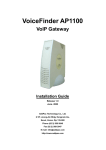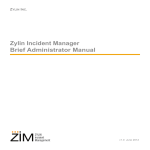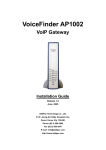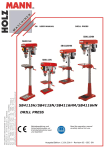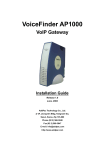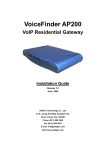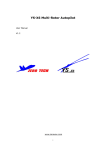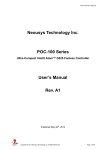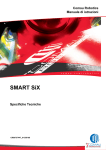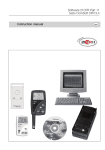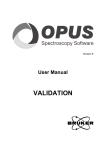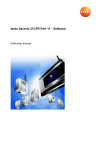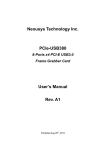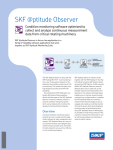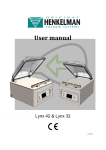Download Manual Tumbler VTU
Transcript
Instruction Manual for Tumbler Screening Machine VTU Product Description 1. Defined Use The Tumbler Screening Machine VTU should only be used for the screening of bulk material and dry products. If the machine is not used according to this definition, the operation of the unit may not be safe. Danger All injuries to persons or damages to the material occurring due to such undefined use will be declined and are the sole responsibility of the user! The machine should never be used for any other than the indicated purpose. It is especially forbidden to use the Tumbler Screening Machine as a mixer or a blender or a dryer. We decline all responsibility with regard to any law of product responsibility for any kind of damages and consecutive damages which may occur due to an incorrect installation or use of the machines supplied by us. 2 2. Assembly The Tumbler Screening Machine VTU assembly consist of: - A machine base with main shaft, V-belt drive and electric motor, to be fixed on the floor. - An adjustment system in order to achieve the three dimensional movement. - A vibrating bottom pan with main pivot in the centre and product outlet for fines - One or more intermediate rings with product outlets - One or more pre-tensioned screen inserts with mesh cloth - One or more anti-blinding systems such as balls - A top cover with inlet and product oversize outlet. Tumbler Screening Machines VTU are being manufactured in stainless steel. Stainless steel surfaces may be polished smooth inside and outside or blasted with glass beads. By use of special profiles which are used for the pan, intermediate rings and the cover a perfect alignment and self-centring of the screens and screen body will be achieved. 3 3. Description of operation Basically the movement of a Tumbler Screening Machine VTU can be compared to natural hand screening. If no data or information is available about the product to be screened, it is recommended to run first trials in the test centre. The results of these tests are the basis for the later optimum use of the screening machine. The product is continuously fed to the centre of the machine from where it spreads uniformly to the outside over the entire screening surface. The finer particles are passing through the screen near the centre and the coarser ones are passing through at the periphery. The material is moved in a spiral way over the screen with increasing acceleration to the outside where the narrow-sized particles will also pass through the mesh. The oversize is normally directed by a deflector - like a simple door - into the outlet. Additionally to the set movement the adjusted deflector opening increases or decreases the retention time of the product on the screen. On each deck the screening process will be repeated. The heart of the Tumbler Screening Machine is the patented adjustment system for the individual retention time of each product to be screened. Between main shaft and main pivot first an eccentric displacement will be adjusted between 20-40 mm. A basic plane rotating movement of the screen body is created. The speed is set between 170-270 rpm. The screen body is inclined radially as well as tangentially towards the drive axis, thus creating the three-dimensional movement. The movement of the machine can be recorded with a special axially mobile pen on a master chart where the movements can be measured exactly. The data can always be transmitted by phone or fax or email for further checking. Optimum settings will be always available and reproducible. The primary necessity for a continuous operation is clean and unclogged or not blinded screen meshes. Otherwise, the capacity and the efficiency of the machine will be reduced. The modular design of the Tumbler Screening Machine enables the installation of very effective anti-blinding systems depending on the products to be screened. 4. Technical Data See attached dimensional drawing. 4 5 General safety instructions 1. RESPONSIBILITY OF THE USER Labour Safety Regulations For Accident Prevention Manual The Tumbler Screening Machine VTU has been designed and manufactured by observing a hazard analysis and choice of the harmonized norms, as well as further technical specifications. It corresponds to today’s technical practice and assures maximum safety during operation. The safety of the machine during operation can only be guaranteed with all the necessary requirements taken. It is the responsibility of the user of the machine to plan these requirements and to control their execution. The user must especially make sure, that • the machine is only used according to its defined use, (see Product Description No.1) • the machine is only operated in perfect, operational condition and that the safety devices are checked regularly for their proper function. • the required personal safety devices for the operators, maintenance staff and other persons are available and being used. • this manual is always available next to the machine in a well readable condition. • only qualified and authorized staff will operate, maintain or repair the machine. • the operating staff will be regularly instructed in questions of operational safety and environmental protection; additionally they have to be familiar with the instruction manual and the safety instructions mentioned therein. • all the safety and warning symbols fixed by the manufacturer on the machine are in place and in well-readable condition. • the manual should be completed with national or companyspecific regulations to prevent any accidents. 6 2. EXPLANATION OF THE USED SAFETY SYMBOLS AND PRECISE SAFETY ADVICES Precise safety advices are given in the following paragraphs to inform about the residual risk during the operation and use of the machine. This risk could endanger: · persons · the product and the machine · the environment The symbols used in this manual shall alert the reader to the safety advices! This symbol alerts when there is danger especially for persons. (danger of death, danger of injuries) Danger This symbol alerts when there is danger for the machine, the material and the environment. Attention The most important aim of these safety instructions is to prevent damages to the machine and injuries to persons. · If the symbol DANGER is shown in an advice there might also be dangers for the machine, material and environment to be expected. · If the symbol ATTENTION is shown in an advice there will be no danger to persons to be expected The symbol used for any advice is not meant to replace the written text which should always be read completely! This symbol does not refer to safety advices, but gives information for a better understanding and implies a more economic use of the machine. Information 7 3. Primary safety requirements in normal operation The machine must only be operated by skilled and authorized staff, knowing the manual and able to work according to it! Before starting the machine you must check and assure that: - only authorized staff are within the working area of the machine! - nobody can be injured, when the machine starts! - nobody is touching the machine or moving parts of it during operation because of the danger of injuries! Check the machine before each start for visible damages and make sure that it will only be operated in a perfect condition! The supervisor must be informed immediately about obvious damages! Remove all materials, pieces and parts which are not necessary for the production from the working area of the machine before starting it! Check and make sure before each start that all safety devices are in perfect condition! 4. Basic safety requirements for maintenance The inspection and maintenance intervals given in the manual must be strictly adhered to! The information for maintenance and repairs of the single components must be observed! Block the access for not authorized staff to the working area of the machine prior to starting any maintenance and repair jobs! Put up a sign showing that maintenance and repair works are going on! 8 Shut off the electric mains switch and secure it by means of a lock prior to starting any maintenance and repair job! The key for the lock must be in the possession of the person doing the maintenance or repair work! Only use lifting devices that are in perfect condition in case of changing heavy machine parts! Make sure that all the parts which will be touched later have cooled down to ambient temperature! All greasing, cooling or cleaning materials must be disposed of according to the environmental safety regulations in your country! Used Oils Works on the electric equipment Repair works on the electric equipment of the machine must only be performed by authorised and skilled electricians! Check the electric equipment regularly! Re-fix loose connections! Exchange damaged cables immediately! Always close the control panel! Permit access only for authorised staff with key and tools. Never splash water for cleaning onto the control panels and any other electric housing! 9 Works on hydraulic and pneumatic equipment Maintenance and repair work on hydraulic or pneumatic equipment should only be performed by especially skilled staff! Prior to starting any maintenance and repair work make sure that the hydraulic or pneumatic system is pressure less! Exchange hoses and pipes in preventative maintenance regularly, even if there are no visible damages. (Manufacturer’s instructions are to be observed!) Before any start-up after maintenance or repair works check all threaded connections for fixed seats. - that all covers, screens and filters have been put back and closed. After having finished the maintenance or repair job and before restarting the production make sure that: - all the tools, parts and pieces which have been used during maintenance and repair have been removed from the working area of the machine! - all liquids which might have dripped out have been removed! - all safety devices of the system are in perfect condition! 5. Environmental protection The environmental regulations - as put down in the environmental legislation of your country - have to be observed during all the work on and with the machine. Especially during installation, repair and maintenance jobs no water hazardous materials such as - grease and oils - hydraulic oils - cooling agents - solvents and cleaning liquids may spoil the soil or reach the sewage water system. Instead, the materials must be stored, transported, recovered and disposed of in adequate containers. 10 6. Requirements to the Operators The user must assure especially that - only qualified and authorised staff are operating, maintaining or repairing the machine - the staff will be instructed regularly with regard to questions of operational safety and environmental protection; they also have to be familiar with this instruction manual and the safety instructions mentioned therein. 7. Special kinds of danger The machine has dangerous, moving, rotating and electric parts. They may cause very severe injuries to the personnel or damages to the material, if the safety protections are removed without authorisation or if the safety or maintenance instructions are not obeyed. No modifications, add-ons or changes to the machine are allowed, which could reduce its safety, without talking to the manufacturer first and without his explicit approval. Spare parts must correspond to the technical requirements specified by the manufacturer. This is only guaranteed by using ORIGINAL spare parts. 11 Transport The Tumbler Screening Machine VTU will always be shipped completely assembled, ready to be connected and to operate and - in most cases - on a transport pallet. The machine has been secured against turning movements by means of a transport safety device. The following points must be obeyed in order to avoid machine damages or life hazardous injuries during the transport of the machine: Danger - The transportation should only be performed by qualified staff observing the safety instructions. - The machine should only be moved or lifted on the lifting points indicated. - Only the lifting devices indicated hereafter should be used for transport. - See the chapter “General safety instructions” 1. Dimensions and weight The dimensions and weight of the machine can be seen from the attached dimensional drawing. 2. Allowed transport devices to the installation site With a fork lift having enough lifting capacity the machine may be transported to its place of installation. Without the pallet the machine may be lifted and carried best with the forks under the protections skirt of the bottom pan. 12 By means of a crane the machine may also be positioned on its foundation or support. Preferably soft ropes should be used in order to avoid damages to the screen body. As the lifting points for ropes the following possibilities are available: - two ropes can be pulled underneath the bottom pan or the protection ring. - 4 lifting eyes can be screwed onto the ends of the clamp screws. Only use lifting devices with enough lifting capability. Danger Make sure that the forks have been completely pushed through underneath the protection ring in case of transport with a fork-lift. Otherwise, the lower protection plate might get damaged. 13 Installation In order to avoid damages to the machine or life hazardous injuries during the installation of the machine, the following items have to be strictly adhered to: The installation of the machine should only be performed by qualified staff observing the safety instructions. Danger - Prior to installation the machine should be checked for any damages during transport. - Especially the torque for the clamp screws and other screws has to be rechecked. - For the later installation a safety distance of 1 m should be foreseen and separated. - See the chapter “General safety instructions”. To avoid the danger of falling down: Danger All machine connections such as cables, hoses, pipes must be positioned in a way that people will not stumble and fall over them. To insure a trouble-free operation: Danger - Prepare a plane and horizontal place for the installation of the Tumbler Screening Machine - The foundation has to be rigid and robust enough for carrying the weight of the machine. - All connections have to be mounted carefully and firmly. 14 1. Requirements for the installation Attention The base of the machine should be screwed firmly to the foundation at the foreseen holes. Under no circumstances must it be welded to the foundation, nor should rubber pads or other vibration damping materials be placed between the foundation and the base of the machine. In case of installation in steel structures they must be designed rigidly and free of vibrations. It must be taken into consideration that the resonance vibration of the machine is close to the one of a steel structure. So, a safety Attention factor has to be calculated. The residual rotating dynamic forces may otherwise shake the steel structure into resonance. Especially with larger machines and high capacities the material in the machine during the screening process should be considered. The dynamic forces are indicated in the dimensional drawing. A safety distance between screen body and rigid parts next to it have to be provided. The vertical and horizontal displacement of the screen body is indicated in the dimensional drawing. Danger No access should be allowed from underneath into the machine base due to the rotating parts and the resulting danger of severe injuries. 2. Removing transport safety device The transport safety device most often consists of flat steel screwed in between the protection ring and pallet or base in order to prevent a turning movement. This part has to be removed. 15 3. Assembly and installation If the machine has been shipped in parts to the installation place, it must be re-assembled in the reverse way as it has been disassembled before. Danger With larger machines the single components have to be transported according to the safety instructions with the corresponding devices, such as a crane or a winch. If the machine is to be used for food or pharmaceutical products, it must be cleaned on the product contact surfaces according to the requirements prior to assembling it. Attention 4. Fixation After positioning the machine on its foundation the base has to be placed horizontally and firmly fixed by means of 4 screws M16. If the machine base is not placed horizontally, tensions may occur and result in damages to the machine. Attention 16 5. Orientation of the outlets and connection of the flexible hoses The evacuation pipes for the different fractions should only be positioned after having installed the machine in order to assure that the flexible hose connections fit perfectly and later their wearing will be reasonable. Information The machine should be turned manually because it rotates with an eccentric of 25-40 mm. It should be obeyed that during operation the machine has a displacement of about 20-30 mm in the sense of the motor rotation. The highly flexible hoses should have a length of at least 1.5 times the diameter. In the case of too short or too rigid hoses resonance modes could occur in the building; the screening movement may be influenced or cracks Attention may appear on the outlets. 6. Advices for the damping of packaging materials The packaging materials consist of wood and plastics. They should be damped or recycled according to local regulations. 17 Start-Up In order to avoid damages to the machine or life hazardous injuries during the installation of the machine, the following items have to be observed: Danger The start-up of the machine should only be performed by qualified staff observing the safety instructions. - Prior to start-up check if all tools or foreign parts have been removed from the machine. - Activate the safety devices and Emergency-OFF switches before startup. - Check the sense of motor rotation prior to start-up. - Check the torque of the clamp screws (20-30 Nm). - See chapter “General safety instructions. 1. Providing power supply Electric installation The motor data on the motor and in the dimensional drawing should be obeyed to. The connection has to be done by the user by means of a lockable mains switch according to VDE 00113, motor protection; other switches have to be provided by the user as well. Check if all the required electric connections are fixed and firm! Danger In the case of an integration of the screening machine into an industrial automatic process it is important that first the discharging machines, then the screening machine and at last the feeding system will be started. Otherwise, the machine might fill up with material and the screens be damaged. Sense of motor rotation: clockwise Information 18 A VTU 2000 and 2400 should be started smoothly and not directly because of the large rotating mass of the screen body. The 5.5 kW motor can be started with a soft starter or in star-triangle with a 5 sec. delay. Information For the permanent surveillance of the operating machine it is recommended to install an optical speed sensor next to the lower V-belt’s counter weights. Information Checking the supply of grease At the manufacturer’s plant the following items have been greased: All the machine bearings have been completely greased but they must be lubrificate every 1000 hours with grease “SKF” LGHP2. 2. Checks prior to first start Check the function of the safety devices in order to avoid machine damages, injuries or deaths of persons: Danger - Prior to the first start-up and prior to start-up after a longer stop. - Every day – before starting work – all the safety devices have to be checked for perfect function. Prior to the first start of the machine the following items should be rechecked: Attenzione 1) Transport safety device removed? 2) Electric connections / sense of motor rotation? 3) Firm seats of the clamp screws (20-30 Nm)? 4) Firm and horizontal seat of the deflectors in front of the 5) Firm seats of all connection screws of the adjustment system counter weights? 6) V-belt tension +- 1 cm? 7) All inspection and maintenance doors firmly closed? 19 Danger In order to avoid damages to the machine or life hazardous injuries during the installation of the machine, the following items have to be observed: - That no persons are working on the machine and that no other persons are in the working area of it. - That no tools or other material are left on the top cover. - Firm seats of the clamp screws (20-30 Nm). The screen body’s components may be thrown away when the screws are loose. 4. First start-up of the Machine After having checked all connections the Tumbler Screening Machine VTU may be started to check the proper function of the safety devices. 5. Checks after the first start-up After the first start with material the machine should be stopped after about 15 minutes at the same time as the feeding system. The material layer on the screens and eventual blinding of the screen mesh holes should be checked. An analysis of the different fractions will give an indication about the screening efficiency achieved. After the first start and prior to continuous use in production the function of all safety devices should be checked! 20 Handling 1. Changing screens For the change of screen inserts first all the clamp screws have to be unscrewed and the flexible hoses removed on one side. Then, the machine can be stripped down from top to bottom. For larger machines it is recommended to use the manual decklifters. After the screen change the assembly has to be done in reverse order. - Mark the position of the outlets before dismantling the machine - New screens should be cleaned and degreased before use, depending on Information the application they are intended for. - The gaskets should be cleaned from product residues prior to assembly. Attention - Especially fine screens are very delicate and should be protected from touching sharp edges. The clamp screws should be re-tightened after 24 h especially after having mounted new gaskets. They should be re-checked every 2 weeks. 21 2. Manual Deck Lifter TECHNICAL DATA OF EACH DECK LIFTER Max. load: 0,5 t transmission: 1:20 crank pressure: 160 N weight: ca. 8 kg without parts added Ca. 15-18 kg with parts added PREPARATION AND POSITIONING The deck lifters are designed for mobile and stationary use. They are making the screen change much easier especially on multi deck machines, because the intermediate rings will be lowered at exactly the same position as they where lifted before. Open all clamp screws and swing them downwards. 22 For VTU 2400 the arrangement is 150° for the first 2 ones and the 3rd one at 90° or 120° of one of the others. For the smaller machine VTU 1200-2000 its 180° for the first 2 ones and 72 or 108° for the 3rd one in case of 4-5 decks machine. FIXATION Where you want to place the deck lifter take the existing clamp screws off after removing the clip and bolt . Open the red safety lock and fix the deck lifter with the screw M16x20 Incline the deck lifter to the outside and move down the supporting arm to the required deck position. The arm must be as close as possible to the intermediate wall. Attention The fixation screw must fixed absolutely tight in order to avoid lateral play. 23 Close the red safety lock. When using the deck lifter the first time check the adjustment of the locking bolt of the safety lock. Attention 24 LOWERING AND LIFTING Move up all the 2 or 3 deck lifters as simultaneously as possible about 100150 mm for checking or removing the screen insert. In case of higher distances, as shown on the lower picture it is recommended to install 2 second safety device with 3 or 4 cables fixed to the ceiling. (see local or internal safety regulations) Later lower the deck lifters and make sure that are placed again at the same position. Small corrections are always possible as long as the parts are not lowered completely. Before changing the next screen deck open the red safety lock prior to inclining the deck lifter outwards. Then move the arm again to the required position. It is important for lowering and lifting that the deck lifters are moved simultaneously in order to avoid tensions and one side loads. Information 25 STATIONARY FIXATION OF THE DECK LIFTERS The deck lifters can be used also stationary fixed on a machine. The force of 5000 N is sufficient to replace a standard clamp screw. The lever can be closed vertically for the “parking position”. SAFETY Attention - The use of these manual deck lifters is safe if the instructions are followed carefully. However heavy loads are lifted and there is always a danger of injury for hands and fingers. - The manufacturer declines herewith all responsibility and liability for what so ever accidents and injuries might occur for any reasons - The user is accepting this declaimer entirely when making use of the deck lifters. Additional safety precautions can be taken by the user if required or specified by local safety regulations 3. Modification of the screen body The Tumbler Screening Machine has a modular design; so, further screen decks or antiblinding systems may be added any time. Each modification results in a change of the screening movement and the dynamic mass balance. The movement parameters should be recorded prior to any change on a master chart. Attenzione - Consult the manufacturer, if a modification is required. The adjustment and balancing of the machine should be done preferably by one of his technicians. - Wrong settings may lead to catastrophic screening results and result in damages of the screen inserts and the machine. 26 5. Grounding/earthening strap (optional) A clamp screw can be equipped with a grounding strap made of a hollow tube and several bolts which can be adjusted to touch firmly the screen frames and intermediate rings. 27 6. Adjustment of the settings Take a master chart of the machine movement prior to each modification. Information ADJUSTMENT UNIT 28 6.1 Adjustment of eccentric radius The eccentric radius is adjustable in a range of 20 to 40 mm. With the same speed of rotation and a larger eccentric the acceleration increases. All modifications of the eccentric result in a change of the dynamic mass balance and impact of the forces to the foundation. Remove the cover on the protection ring and loosen the 4 hexagonal screws [232] holding together the main counter mass and the adjustment plate. Loosen the counter nut and adjust the eccentric screw [212] as required and retighten the screws [232]. Put the cover back and draw up the ellipse on a master chart. To the inside: eccentric smaller To the outside: eccentric larger 6.2 Adjustment of The Radial Inclination The radial inclination is throwing the material straight from the centre to the periphery. Too high radial inclination: centre empty, accumulation outside Too low radial inclination: high product layer on the screen Remove the cover on the protection ring and loosen the 2 hexagonal screws [233] the turn bolt [204] the adjustment segment [203] (in form of a peach) with the welded on main pivot and adjustment plate [202]. Loosen the counter nut [254,255] and adjust the radial inclination with the nuts [254,255] as required and retighten the nuts finally. Keep in mind that the eccentric will also be altered. To the right: radial und eccentric larger To the left: radial und eccentric smaller Put the cover back and draw up the ellipse on a master chart. 6.3 Adjustment of the tangential inclination The tangential inclination is throwing the product in a circle from the inside to the outside. Too high tangential inclination: centre full Too low tangential inclination: high product layer on the outside Remove the cover on the protection ring and loosen the 4 hexagonal screws [232] holding together the main counter mass and the adjustment plate. Loosen the counter nuts [237] and adjust the tangential inclination as required and retighten the nuts finally. Keep in mind that the eccentric will also be altered. Move plate downwards: tangential and eccentric larger Move plate upwards: tangential and Eccentric smaller Retighten all the screws and draw up the ellipse on a master chart. 29 7. Adjustment of the deflectors The deflectors in front of the outlets give an additional possibility to increase or decrease the residence time of the material on the screen. A widely open deflector guides the material faster from the screen than one further closed. Deflectors which are adjustable from the outside will make the adjustment easier and are fixing the last position. The firm and horizontal seat of the deflector on the screens must be checked after each screen exchange. Attenzione A deflector which is closed too far may result in screen damages due to overloading. A deflector not sitting firmly on the screen may result in screen damage and reduce the screening efficiency. 8. Checking the machine adjustments The large amplitude can easily and exactly be recorded on a master chart and will appear as an ellipse. By use of a simple curve writer with a pen the ellipse will be drawn on a sheet of paper and measured afterwards. Optimum parameters can be “stored“ in this way and reproduced later at any time. 30 Procedure: With a self adhesive tape a piece of strong paper is fixed to the bottom pan. The curve writer is placed on a strong support next to the machine and the pen is pulled back completely. The support should not touch the machine body, minimum distance 50 mm. With your finger tips narrow the pulled-back pen to the paper until it is touching it. Then the machine is moved horizontally from the left to the right side and back by pulling on a clamp screw. The horizontal reference line is drawn. Pull the pen back. Start the machine and let it operate for 1 minute until it stops moving from left to right. Now press the curve writer firmly onto the support and pull the pen back. Let the pen then drop softly onto the paper and wait for 3-5 rpm. Pull the curve writer off abruptly. Now, the paper can be removed, and the ellipse being measured with a ruler. The thickness of the ellipse is the radial inclination. The inclination of the ellipse towards the horizontal line is the tangential inclination. The length of the ellipse is 2 x the eccentric or radius. 31 32 9. Mass balance, dynamical When the machine is placed on a concrete foundation with loosened fixation screws it will not move. The optimal mass balance has been realised in the manufacturer’s production plant. - When the machine is installed within a steel structure, there can always be vibrations or resonance, depending on the construction of the steel structure.In most cases the vibrations can be reduced, if not stopped, on site Information by rebalancing the machine by one of our technicians. - Steel structures should always rigid and vibration-free! - In case of an absolutely vibration-free installation the machine can also be hung on chains. 33 Maintenance 1.1 Exchange and control of the bottom pan bearings The bottom pan has two tapered roller bearings. After a longer operation the bearings may have a play which can be detected by trying to lift the bottom pan outlet. For re-adjustment the machine has to be stripped down to the bottom pan. After removing the bearing cover or the reduction gear-box the crown nut can be readjusted after loosening the safety ring. After the adjustment the safety ring has to be locked again. The bearings should not be over-tightened. If the bearings are worn out and a sound is to be heard, they will have to be replaced. Remove the bearing with pulling device. The inner bearing ring should be heated shortly on the outside for removal. Always exchange both of the bearings and if necessary change the shaft sealing rings and other parts as well. The free space should be filled with grease and the bearings covered. After assembly readjust the bearing play. The general rules and instructions for the mounting of bearings should be observed. If the bearings are over-tightened they will heat up; decrease the bearing tension and increase the play slightly. 1.2 Exchange and control of the base bearings The base has two tapered roller bearings. If only the lower bearing shall be changed, first the counter weights and the V-belt pulley must be removed. Access from underneath must be possible or the base must be inclined 90°. Remove the bearing cover and safety ring and nut for the fixation of the bearings. Pull off the bearing and put in a new one after having cleaned the seats from any old grease. For the exchange of both bearings at the same time, the screen body must be separated from the base by loosening the 4 screws from the eccentric adjustment plate. Pull off the lower bearing as described above. After opening the upper bearing cover the main shaft can be removed with a winch or a crane. Exchange the upper bearing, put grease in and reassemble the unit. Grease again later. The general rules and instructions for the mounting of bearings should be observed. If the bearings are over-tightened they will heat up; decrease the bearing tension and increase the play slightly. 34 1.3 Tension of V-belt drive The V-belts can be re-tightened by moving the electric motor out by means of the adjustment screw. - Check the tension every 3 months (+- 1 cm) Attention - Too low a tension will increase the wear and lead to warming up and reduced speed. 1.4 Re-meshing of screen frames All screen frames can be re-meshed several times when the mesh cloth needs to be replaced. The re-meshing requires a tensioning unit and some experience. We offer a prompt and fast re-meshing service for all screen sizes and designs. The screen frames can be covered with steel, stainless steel, spring steel, plastic mesh cloth or perforated plates. Rectangular mesh openings instead of square meshes are also available Of course, the screens can also be re-meshed on site. The necessary accessories and the instructions can be offered. - Regularly check the tension of the screens and their shape. Attention - Replace lose or weak screens immediately. The screening efficiency might be reduced otherwise. 35 Anti-blinding systems Ballcleaning This anti-blinding system has a simple and easy handling feature. Rubber balls made of special rubber mixtures are jumping on a perforated plate against the bottom side of the screen while removing the grains sticking to the holes. The rubber balls are available in Natural Rubber and in Silicon. The standard diameter is 30 mm. The balls are having the best efficiency when the machine speed is higher than 200 rpm. At a higher speed the balls are jumping with more energy. - Check the wear of the balls every 4 weeks. When they have reached a diameter of 23 mm, they should be replaced. Attention 36




































